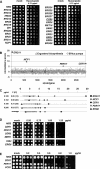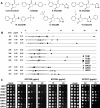Genome-wide fitness test and mechanism-of-action studies of inhibitory compounds in Candida albicans
- PMID: 17604452
- PMCID: PMC1904411
- DOI: 10.1371/journal.ppat.0030092
Genome-wide fitness test and mechanism-of-action studies of inhibitory compounds in Candida albicans
Abstract
Candida albicans is a prevalent fungal pathogen amongst the immunocompromised population, causing both superficial and life-threatening infections. Since C. albicans is diploid, classical transmission genetics can not be performed to study specific aspects of its biology and pathogenesis. Here, we exploit the diploid status of C. albicans by constructing a library of 2,868 heterozygous deletion mutants and screening this collection using 35 known or novel compounds to survey chemically induced haploinsufficiency in the pathogen. In this reverse genetic assay termed the fitness test, genes related to the mechanism of action of the probe compounds are clearly identified, supporting their functional roles and genetic interactions. In this report, chemical-genetic relationships are provided for multiple FDA-approved antifungal drugs (fluconazole, voriconazole, caspofungin, 5-fluorocytosine, and amphotericin B) as well as additional compounds targeting ergosterol, fatty acid and sphingolipid biosynthesis, microtubules, actin, secretion, rRNA processing, translation, glycosylation, and protein folding mechanisms. We also demonstrate how chemically induced haploinsufficiency profiles can be used to identify the mechanism of action of novel antifungal agents, thereby illustrating the potential utility of this approach to antifungal drug discovery.
Conflict of interest statement
Figures








Similar articles
-
Genome-wide expression profiling of the response to terbinafine in Candida albicans using a cDNA microarray analysis.Chin Med J (Engl). 2007 May 5;120(9):807-13. Chin Med J (Engl). 2007. PMID: 17531123
-
Genome-wide expression profiling of the response to azole, polyene, echinocandin, and pyrimidine antifungal agents in Candida albicans.Antimicrob Agents Chemother. 2005 Jun;49(6):2226-36. doi: 10.1128/AAC.49.6.2226-2236.2005. Antimicrob Agents Chemother. 2005. PMID: 15917516 Free PMC article.
-
Inhibition of Candida albicans growth by brominated furanones.Appl Microbiol Biotechnol. 2010 Feb;85(5):1551-63. doi: 10.1007/s00253-009-2174-6. Epub 2009 Sep 16. Appl Microbiol Biotechnol. 2010. PMID: 19756586
-
Candida and candidaemia. Susceptibility and epidemiology.Dan Med J. 2013 Nov;60(11):B4698. Dan Med J. 2013. PMID: 24192246 Review.
-
Human fungal pathogen Candida albicans in the postgenomic era: an overview.Expert Rev Anti Infect Ther. 2009 Feb;7(1):121-34. doi: 10.1586/14787210.7.1.121. Expert Rev Anti Infect Ther. 2009. PMID: 19622061 Review.
Cited by
-
Comparative interaction networks: bridging genotype to phenotype.Adv Exp Med Biol. 2012;751:139-56. doi: 10.1007/978-1-4614-3567-9_7. Adv Exp Med Biol. 2012. PMID: 22821457 Free PMC article. Review.
-
Investigating Common Pathogenic Mechanisms between Homo sapiens and Different Strains of Candida albicans for Drug Design: Systems Biology Approach via Two-Sided NGS Data Identification.Toxins (Basel). 2019 Feb 15;11(2):119. doi: 10.3390/toxins11020119. Toxins (Basel). 2019. PMID: 30769958 Free PMC article.
-
Gymnemic acids inhibit hyphal growth and virulence in Candida albicans.PLoS One. 2013 Sep 11;8(9):e74189. doi: 10.1371/journal.pone.0074189. eCollection 2013. PLoS One. 2013. PMID: 24040201 Free PMC article.
-
Microtubule motor protein Kar3 is required for normal mitotic division and morphogenesis in Candida albicans.Eukaryot Cell. 2008 Sep;7(9):1460-74. doi: 10.1128/EC.00138-08. Epub 2008 Jun 27. Eukaryot Cell. 2008. PMID: 18586948 Free PMC article.
-
Efg1 Controls caspofungin-induced cell aggregation of Candida albicans through the adhesin Als1.Eukaryot Cell. 2011 Dec;10(12):1694-704. doi: 10.1128/EC.05187-11. Epub 2011 Oct 28. Eukaryot Cell. 2011. PMID: 22037180 Free PMC article.
References
-
- Pappas PG, Rex JH, Lee J, Hamill RJ, Larsen RA, et al. A prospective observational study of candidemia: Epidemiology, therapy, and influences on mortality in hospitalized adult and pediatric patients. Clin Infect Dis. 2003;37:634–643. - PubMed
-
- Wisplinghoff H, Bischoff T, Tallent SM, Seifert H, Wenzel RP, et al. Nosocomial bloodstream infections in US hospitals: Analysis of 24,179 cases from a prospective nationwide surveillance study. Clin Infect Dis. 2004;39:309–317. - PubMed
-
- Braun BR, van het Hoog M, d'Enfert C, Martchenko M, Dungan J, et al. A human-curated annotation of the Candida albicans genome. PLoS Genet. 2005;1:e1. doi: 10.1371/journal.pgen.0010001. - DOI - PMC - PubMed
-
- Kellis M, Birren BW, Lander ES. Proof and evolutionary analysis of ancient genome duplication in the yeast Saccharomyces cerevisiae . Nature. 2004;428:617–624. - PubMed
Publication types
MeSH terms
Substances
LinkOut - more resources
Full Text Sources
Other Literature Sources
Molecular Biology Databases

